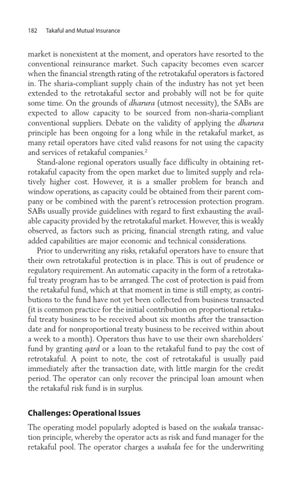182 Takaful and Mutual Insurance
market is nonexistent at the moment, and operators have resorted to the conventional reinsurance market. Such capacity becomes even scarcer when the financial strength rating of the retrotakaful operators is factored in. The sharia-compliant supply chain of the industry has not yet been extended to the retrotakaful sector and probably will not be for quite some time. On the grounds of dharura (utmost necessity), the SABs are expected to allow capacity to be sourced from non-sharia-compliant conventional suppliers. Debate on the validity of applying the dharura principle has been ongoing for a long while in the retakaful market, as many retail operators have cited valid reasons for not using the capacity and services of retakaful companies.2 Stand-alone regional operators usually face difficulty in obtaining retrotakaful capacity from the open market due to limited supply and relatively higher cost. However, it is a smaller problem for branch and window operations, as capacity could be obtained from their parent company or be combined with the parent’s retrocession protection program. SABs usually provide guidelines with regard to first exhausting the available capacity provided by the retrotakaful market. However, this is weakly observed, as factors such as pricing, financial strength rating, and value added capabilities are major economic and technical considerations. Prior to underwriting any risks, retakaful operators have to ensure that their own retrotakaful protection is in place. This is out of prudence or regulatory requirement. An automatic capacity in the form of a retrotakaful treaty program has to be arranged. The cost of protection is paid from the retakaful fund, which at that moment in time is still empty, as contributions to the fund have not yet been collected from business transacted (it is common practice for the initial contribution on proportional retakaful treaty business to be received about six months after the transaction date and for nonproportional treaty business to be received within about a week to a month). Operators thus have to use their own shareholders’ fund by granting qard or a loan to the retakaful fund to pay the cost of retrotakaful. A point to note, the cost of retrotakaful is usually paid immediately after the transaction date, with little margin for the credit period. The operator can only recover the principal loan amount when the retakaful risk fund is in surplus.
Challenges: Operational Issues The operating model popularly adopted is based on the wakala transaction principle, whereby the operator acts as risk and fund manager for the retakaful pool. The operator charges a wakala fee for the underwriting
